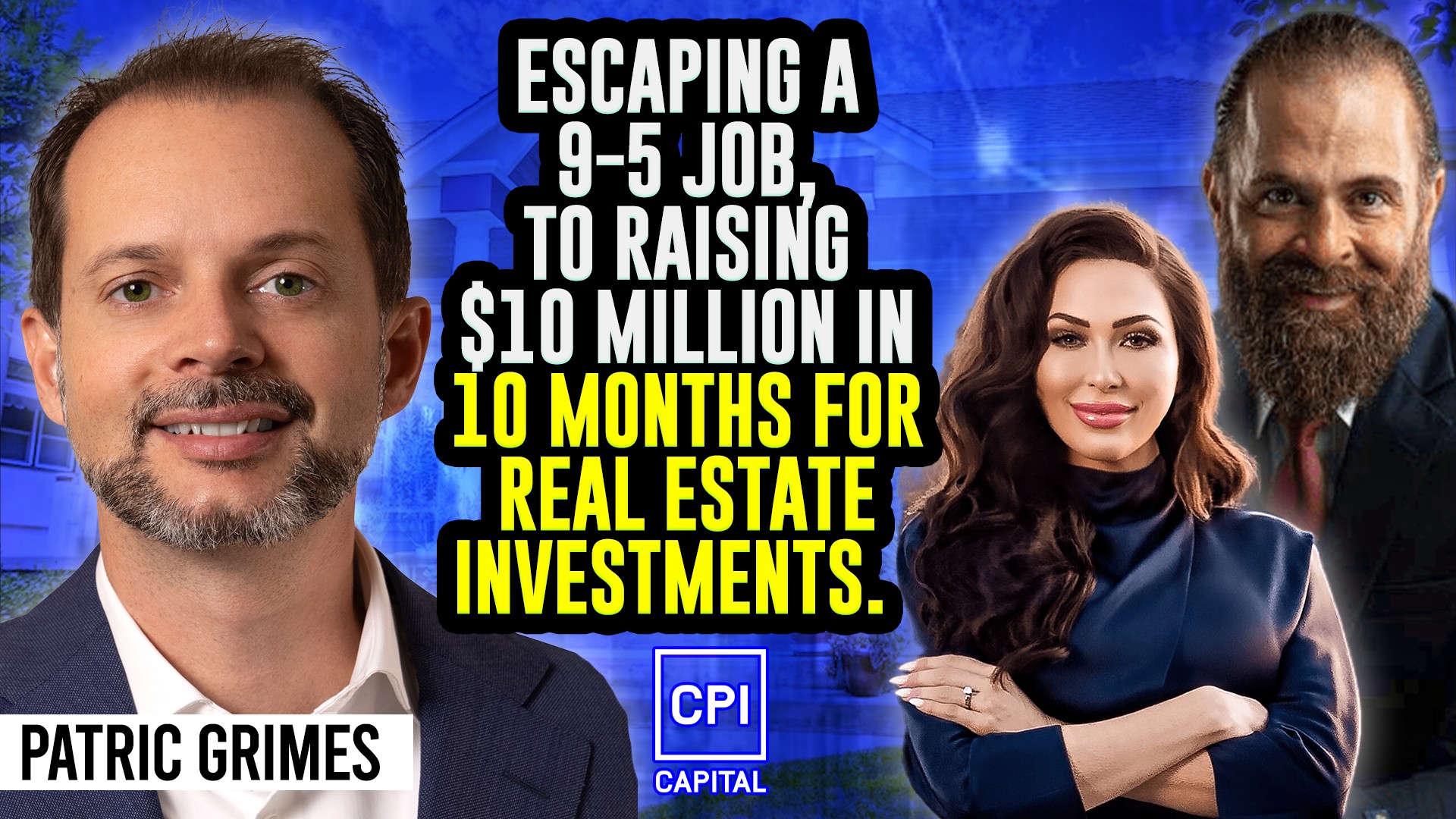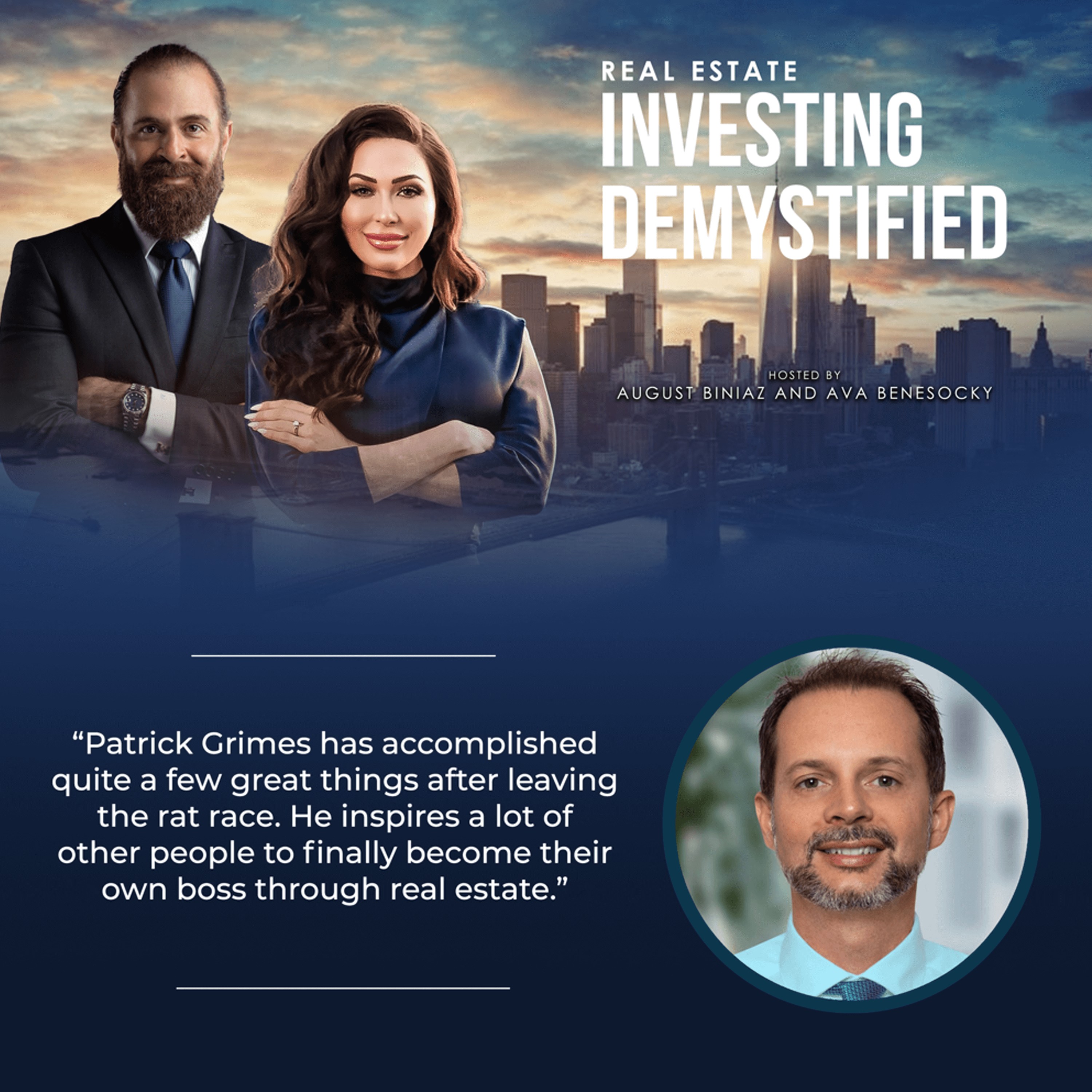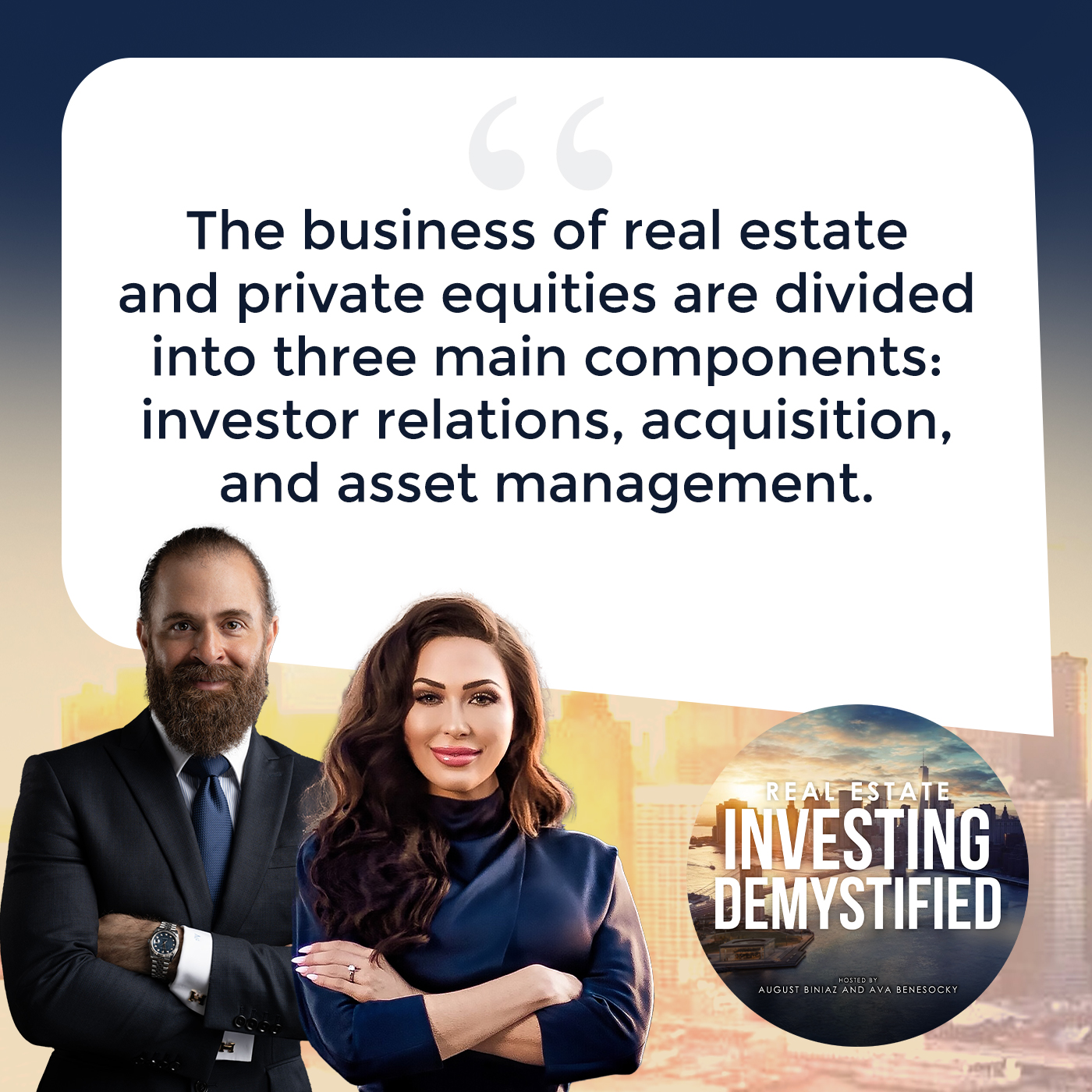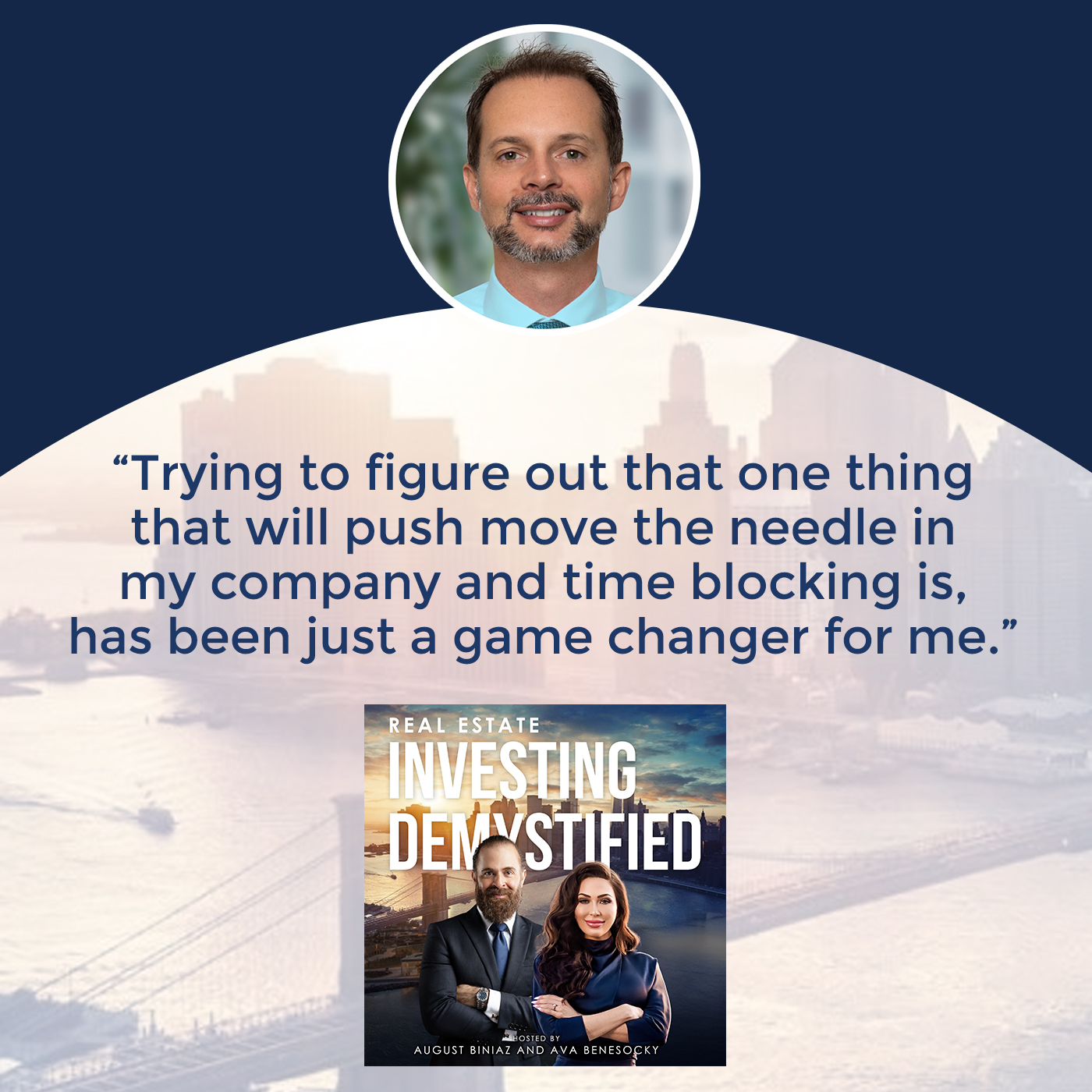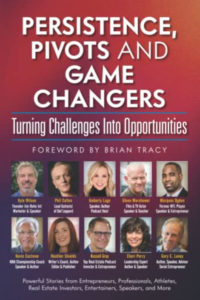Whether you’re a working executive, an ultra-successful entrepreneur, or stuck in the rat race with no end in sight, this episode will provide the steps you need to take to finally become the boss of your life! With special guest Patrick Grimes, founder and CEO of Invest at Main Street, we’ll be discussing how to start investing in real estate and how much of a game-changer it can be if you do it right! Tune in now to learn how to work less, earn more and create a life of adventure!
Connect with Patrick Grimes:
LinkedIn: http://linkedin.com/in/patricksgrimes
Website: https://investonmainstreet.com/
If you are interested in learning more about passively investing in multifamily and Build-to-Rent properties, click here to schedule a call with the CPI Capital Team or contact us at info@cpicapital.ca. If you like to Co-Syndicate and close on larger deal as a General Partner click here. You can read more about CPI Capital at https://www.cpicapital.ca. #avabenesocky #augustbiniaz #cpicapital
—
Watch the episode here
Listen to the podcast here
Important Links
- Invest On Main Street
- Persistence, Pivots, and Game Changers
- 1-Minute-to-Cashflow
- Passive Investor Guide
- ActiveCampaign
- 1031 Exchange Guide
- The Rich Dad Poor Dad
- The ONE Thing
- Patrick@InvestOnMainStreet.com
- https://www.Linkedin.com/in/patricksgrimes/
About Patrick Grimes

Quitting The Rat Race: How To Escape Your 9-5 Job And Raise Millions In 10 Months With Patrick Grimes
I’m excited about our guest, and our first guest is coming back. Patrick Grimes is on our show. We bring exciting guests and expert guests. He’s doing his rounds around lots of different podcasts and YouTube shows. We are excited to have him and hear his journey, and it matches with a lot of the different guests we’ve had. I met Patrick in person at the MFIN Conference in Seattle.
I recognized him somewhat, but I couldn’t put a name to the face. I knew I knew him from somewhere. We connected. I got to meet him. I believe I met his lovely wife as well. I am excited to have him on the show and get that going. I want to talk about that. He maybe can tell our readers who Patrick is, what he’s been up to, and what his involvement in real estate private equity is.
He’s accomplished some pretty great things. Let’s get into it. Patrick is the Founder of Invest On Main Street. He has several years of experience in active real estate investment, purchasing distressed assets, renovating, and stabilizing for long-term cashflow. His company’s $200 million-plus portfolio includes 2,700 units in multifamily apartment communities in emerging markets across Texas and the Southeastern United States.
Patrick co-sponsors syndications with strengths in underwriting, conducting due diligence, authoring pitch decks, and raising equity with $20 million plus, and you mentioned $30 million plus now invested from his network of passive investors. That’s a great accomplishment there. Patrick co-authored an Amazon number-one bestselling book. It’s called Persistence, Pivots, and Game Changers. That’s great, and Patrick’s going to talk a little bit more about that. He also holds a BS in Mechanical Engineering, a Master of Science and Engineering, and an MBA.
At the end of the show, stay tuned because he’s going to give a free copy of his book to one of our lucky readers. Patrick, let’s start the show.
Thank you so much for being here, Patrick. Please tell us about your background and your start in real estate.
You did that whole introduction. I got to echo that back at you. I have enjoyed your guys’ channel, and you have great content. Somehow, I got on your list. I think it was Bronson’s episode. He is a good pal of mine. You guys send out great blogs. You’ve got intelligent things to say. You’re inventing some cool terms, which I jive with, like the Real Estate Private Equity or REPE stuff. I was impressed by what you guys had, so I’m glad that we finally got to get on and have a chat. I’ve heard of you from other people that you guys are up to some pretty amazing things, so I’m honored to be on your show.
The honor is all ours. Tell us about your background. We know you’re an engineer who got into real estate private equity. It doesn’t sound that good. Real estate private equity sounds way better, but you got involved in this business. Tell us about your background and your start in real estate. We’ve got a bunch of questions for you.
I’ve been an engineering machine design, automation, and robotics guy for a few years more than I’ve been in real estate. When I first started as an engineer, the owner of the company I was working for at this machine design firm said, “You need to put your money not only in high-tech stocks. You need to put it in real estate. Everything I make, I put in real estate, and you should do the same as much as you can in as early as you can.” I saved up every penny I had, and the first chance I got, I dumped it all into the highest returning investment I could, which was a pre-development residential. That was in 2007. I had personally guaranteed those loans, and they were all fully recourse. ‘08, ‘09, and ‘10 happened, and I rode that down hard.
A quick question for you. These were pre-sale. Were you buying it from a developer, or was this a syndicated investment? Tell us a little bit more about that.
I was purchasing inside an area where a group of us were each buying sections of it, and we were going to do the pre-development entitlements and build on it. It wasn’t syndication, but it was a joint venture of a crowd of individuals all buying up lots with the intention to develop it.
Also, sell it. That was the idea.
It’s either build or hold to rent or sell it at the end of time, but I was like, “I’m going to be a developer. This is how everybody gets rich. The market’s never going to go down. This is 2007.” I did everything everybody told me to do, and that’s to dump every penny, but I didn’t understand market swings. I didn’t understand risk. I didn’t understand recession-resilient markets and diversified employment makeup.
I didn’t understand what a full recourse loan personally guaranteed and recourse states were. I learned quickly all about foreclosure. I wrote that down as I saw the properties eventually as I paid out to get it auctioned off. On the other side of it, I was able to avoid BK or bankruptcy by negotiating debt forgiveness from the third lender that bought my note. It was hard to even find them, but I had an attorney to locate them and negotiate. After paying for years and then negotiating debt forgiveness, I ended up paying taxes on that forgiveness because the bank wrote it off as a loss and the IRS 1099 me for that loss.
I was paying income tax on that forgiveness for years to come. I didn’t even know that was going to happen. Meanwhile, I’m like, “I don’t want to go BK. I’m not going to do it.” Everybody is like, “Just go bankrupt.” I’m like, “No.” That took years to crawl out of. I was young. I was in my career, but early on, I had the fortunate opportunity to be humbled. At that point, I decided, “I’m going to be the tortoise. I’m not going to be the hare.”
If I put my investor hat on and I hear about your story, and you have been through multiple real estate cycles and have been through where your knees are bloody, dirty and you picked yourself back up, I would have more trust in you as a sponsor than if you’d never been through cycles.
I agree. To some extent, I lead with that because failure breeds success. Even in the high-tech world, a lot of CEOs won’t hire you unless you’ve been through a failure or two in the startup world. It rings true for me as well. I 100% get it because oftentimes, now, when I’m talking to individuals about deals, I’m asking them questions about what happens when the economic models break down or the demand shifts this way. How’s the employment?
They don’t even understand the questions I’m asking. “What happens when your debt service coverage ratio drops to this point, and then all of a sudden, it becomes recourse? What are you going to do?” The scenario planning and that mindset because they’ve only been around and only seen this, they don’t have a fear of that in them. They don’t get it. In all of the pitch decks, every single time it has a line on the financial underwriting and conservative, it says, “Underwritten with an eye towards what happened in ‘08, ‘09, and ‘10 versus 2015 through ‘19.” We can talk about it at one point, but there are a bunch of different ways that we make sure that those deals can write out recessions.
Back to your story, I crawled out of that. I dove back into my career and got two Master’s degrees. I was traveling all over and succeeding, but I had this voice in my head, “You got to get all your money out of high tech because this will happen again.” I saw my stocks go down too. I saw the tech crash as well. At the same time, I went and started researching the most recession-resilient markets, the ones where they had diversified employment where you can plot the data, and you see it level off and then go back up again instead of the market switch tanked for 12 to 14 years. I started learning about assets that you can invest in that are undermanaged, mismanaged, under-renovated, and trailing market units, but there’s a proven business plan surrounding them.
A quick question for you, Patrick. Some of our guests were passive investors who were solicited by sponsors or other wealth manager types. They were introduced to this business, real estate private equity on the investment side. That wasn’t the case for you. You were always intrigued by real estate. You got involved in it. You hit an unlucky turn in 2008, but then you’re still researching and trying to find more. Is it fair to say that it was the case? You’re trying to realize what the best model within this business of real estate is?
Yes, I came from, “I have money to invest. Where am I going to put it for first to highest return?” After that, it became, “Where am I going to put it, so I don’t lose it all again and get high-risk adjusted returns?” I started seeking in every book, event, or course I picked up or podcast because I run in the morning and listen to podcasts, including yours. In fact, one morning, I did run into Bronson’s podcast right here on the beach in Newport. Each one sheds a little light on different methods. You’ve got some flashy objects, self-storage or build-to-rent, all these different things. You can start learning like, “You can go this way or that way.”
There’s no light at the end of the tunnel. What I found to be the path that is the more tried and true recession resilient and longer path and not the highest cashflowing or the highest return is existing construction, 20 to 50-year-old buildings that you can do a measurable lift right when you buy. You can easily meet a cashflow very early, if not on day one. That way, at any time the music stops, you can write it out as long as you’re low-leveraged.
I started just trying to find ways to invest my own money. I started doing that in single-family, three-bedroom, and two-bath. That was working great. I was buying, renovating, refi-ing, holding, buying, and renovating. I was moonlighting that with my engineering career. I met my wife and couldn’t moonlight that anymore because I had better things to do. That’s when I decided to trade up into multifamily.
You were utilizing the value add business model in single-family, but then you wanted to scale. Since you were already in this space, you’re looking at multifamily.
A quick question for you, Patrick. How did you get introduced to multifamily and, in particular, real estate private equity? How did you get involved?
This idea of raising capital, investor GP/LP structure, and all that fun stuff.
I was looking at a lot of stuff because I realized that the single-family thing was a ton of time. It was a ton of energy, and it was ramped. Every time I had a vacancy, it would cripple my cashflow. Every year, I held it thereafter. My big win and my good deal, the return would taper. I knew that there had to be another way where I could continue to scale. I had looked at a lot of wild deals. I looked at commercial stuff. I looked at assisted living. I looked at Airbnb rentals. Eventually, I started listening to podcasts. Michael Blank was one of them.
I picked up a Dave Lindahl book and went to a Lifestyles Conference. I went to all these things. As I said, each one of them shed a little more light, but I started resonating with a multifamily space because you can have big enough to have onsite property management. You can work with sophisticated private equity guys and asset managers with decades of experience. You get a better tax advantage. You get non-recourse debt. You can buy workforce housing where a vacancy doesn’t matter. You plan on the vacancy. In fact, you can have breakeven occupancies that are way down in the ‘70s, well below where it dropped in prior downturns and cashflow all the way through. You can’t do that in single-family and things like vacation rentals. They’re a lot more recession-volatile as long as you’re in the right markets.
It’s a lot of pieces of information pointing me toward that. I took my wife to a conference, and I was like, “I’m not going back to single-family.” We just got married in California, and then in Beijing, I was on a horse with a red suit with a dragon. She had a carrier with a phoenix, and it was insane. After that, I was like, “We’re going to do multifamily.” She’s like, “What is that?” I’m like, “I’ll tell you.” It took her a while to get on board, but then we went after it.
I’m excited to hear about the first syndication that you did and what role you played. Did you partner with another group? Did you take a smaller multifamily down by yourself?
The first syndication that closed was about a two-and-a-half-year period since I announced, “This is what I’m going to do,” and I finally got into a deal. There are a lot of engineers out there that are still pondering, calculating, and considering the idea of getting into real estate. It’s a little bit of analysis-paralysis in my space because we analyze and analyze. It did take a while. We’d flown all over, met a bunch of people, underwrote tons of deals, and met lots of brokers. I started out finding and analyzing deals because I’m good at that.
I was doing due diligence on deals and putting offers on deals. Also, bringing them to sponsors that had track records and experience that I knew if I partnered with them, I could learn alongside them, have a lower-risk deal, and build a track record for my own company. That’s how I got into it. In fact, there were a couple of deals that fell out during COVID that we got real close on, and it wasn’t until I finally brought a bazillion deal to one of the guys that he goes, “Let’s work on this one.” The first one, he was like, “I have another deal,” and it’s a small 86-unit. “I’m a single-family, but I got these big multi-hundred deals. Could you help me out with this one? I’ve got these other things.”
I’m like, “What do you want me to do?” He’s like, “Everything you can do.” We were living in O’ahu at the time, and I was red eyeing back and forth for that. I did everything he asked me to do. I didn’t know what my partnership role was going to be or what percentage or whatever. I didn’t care. I only wanted to be in the space. It had been a long time. After the first one, he got addicted to me. He’s like, “Let’s do this one,” and then the next one, and then the next one. That’s how I joined up. It worked out well.
Was this individual a coach? Were you part of a mastermind group? How do you connect with this sponsor?
I didn’t do Michael Blank’s coaching, but I did his Ultimate Guide. It was one of the four guides that I studied. I was in another master’s program, and then I joined his Slack channel. It came for free. That allowed me to upload underwriting. They would analyze it and tell me my feedback and everything. I learned how a lot of the coaching on how to do the mechanics of it from another engineering syndicator like Michael Blank. We learned about Rod Khleif’s group, and they were at an event out in LA.
We intended that, and that’s when my wife fully got on board because that was all of a sudden passive income, and financial freedom coming from Asia didn’t make sense. At the end of that one, that possibility and motivation that it brings, she created a vision board, and we were both off to the races together and joined the coaching with them. Ultimately, the deal we partnered with wasn’t related to the coaching. It was networking and proving myself as somebody who is going to stick with it and show up and add value.
I want to quickly jump into the dynamic between you and your wife and what role you guys play.
Believe it or not, she’s in the production animation and feature-length animated films. She got her Master’s degree at CalArts in Animation. She started with Disney right out of her Master’s program. Before that, she was at the Beijing Center for the Arts, Beijing Dance Academy and then the Vienna Phil Orchestra. She’s pretty incredible. She’s done a lot of amazing things. She’s very artistic. She also got a perfect score on her Math exam.
I’d be sitting there underwriting, and she’d be correcting the Math in her head. She does some amazing stuff. Early on, she was traveling with me, and I had a companion pass. She was traveling for free, and we’d go around every chance we’d get. She’d help woo the brokers, and I was like, “Work your magic. We need to get this offer.” She was involved in that. After a while, her career started. Now she does production management for wild stuff, and she’s doing well. Now, she’s more in charge of investor education. She’s got a big cashflow series, 1-Minute-to-Cashflow. You can subscribe to her on our website. She’s produced 80 videos that you can tune into. Those are daily 1-Minute-to-cashflow videos. It’s pretty cool. I’ve run with the company at this point in the other areas.
I want to break down your start in the space, and it’s very important, especially for the passive investors reading, or people trying and break into the space or scale in these spaces. When Patrick started out, the business of real estate private equity was divided into three main components. It’s the investor relations and investor cultivation. It is the equity side of the business. It’s the acquisition, which is deal sourcing, connecting with brokers, and underwriting. Also, you got the asset management, which is executing the business plan.
When we started out, our focus was right away on the equity side, like building a brand, connecting with investors, and investor relations. That doesn’t have to be the case every time you get involved in this business. Patrick started on the deal side looking at deals, underwriting deals, leveraging his experience and background, which was he’s an engineer, is great with numbers, and has an analytic mind to then look at deals and underwrite them. I want to touch on that. There are different ways to get involved in this business and excel.
I love it when you touch on that. We call it the pie.
The topic of the show is going to be talking about $10 million in ten months. Maybe we can talk about that. It’s a great segue because we talked about your focus initially being dealt with, finding deals, connecting and bringing deals to sponsors and other partners, and doing deals together. You’re talking about anything about raising capital, connecting with investors, the whole funnel and the investor journey.
This is my favorite part. This is my favorite question to ask. I would love it if you give us a crash course on capital raising and talk to us about your journey of raising $10 million in ten months.
Go early on and go as in-depth as much as you can about this because a lot of people can’t even fathom it. I was in real estate for many years, but when I talked to my mom, which whom I’m very close, and I’m like, “I’m going to raise money from people. They’re going to give me money, and I’m going to take that money. I’m going to go buy real estate, and I’m going to upgrade and update,” she’s like, “Why would they give you money?”
I’m like, “Mom, the whole world runs like this, the world of private equity. There’s $10 trillion being managed by BlackRock because people give them money, and they take the money and invest in the stock market.” She’s like, “Why don’t they do it themselves?” I’m like, “Because they’re experts, mom.” The idea early on, some people can’t understand the concept of people giving you money and you working with it.
It takes them a second to wrap their head around it because when people think of real estate investing, they think of actively investing in their own property. Please go ahead, Patrick. I’m excited for you to dive into this.
Originally, capital raising wasn’t going to be my focus. I was coming from a single family. I’m going to do it all, and it was when I finally said, “I need to partner because I see every deal going to experience syndicators that had bought and sold with these brokers over and over again.” For people with a net worth and liquidity of $50 million to $100 million that can take down loans with favorable terms, I needed a partner.
When I got into a deal, it was because the guy needed help. He needed somebody who was a go-getter that he could rely on to get things done, and it would show up and not be a washout. There’s a 90% dropout from when I’ve spoken to coaches in this space. People think it’s a get-rich-quick scheme, but it’s a ton of work. At that first deal, it wasn’t, “We need you to raise X capital.” It was like, “You want to get the help to get this deal done.”
I’ve only done a Reg D 506(c). That would be accredited investors only and a $100,000 minimum. I’ve only ever done deals like that. That eliminates probably 95% of the people you might typically run across because they don’t have $200,000 in income or $300,000 with their spouse, or $1 million in net worth, not including their home. In California, most people’s net worth is in their homes. They don’t make it by income.
On that deal, I knew that it was part of it. I knew that if I was ever going to go out and do it on my own, I needed to get that going. We did create a website. I wrote a lead magnet, which talks about my journey and the case for it, which is a Passive Investor Guide, and I still get tons of downloads on that regularly, 3 or 4 downloads on it per day. I haven’t updated it since then, but it’s still all true because it was written to withstand a cycle. I wrote that and started telling people about what I was doing. I came from a machine design and automation background, so I had been entrusted by various executives with millions of dollars to build a higher-risk profile custom one-of-a-kind machines that would manufacture medical devices, solar cells, and rockets.
I had some people that I had developed relationships with over a decade from my Master’s program or childhood of friends that had done well. I pick and choose. I didn’t want to do friends and family. I didn’t do what I would consider real friends, and only people that I knew were investor-savvy. I didn’t do any family. Mostly because that was a lot of their net worth for me, and I wanted to keep this business. That’s how I started.
I started building a platform, a website, a video that tells my story, and a lead magnet telling people about it and getting them there. I got ActiveCampaign. I started sending out emails. People started opting into our deal. The first deal I raised was well over $600,000, and on the next deal, I doubled it. It went from there. The first one was people that I had known for over ten years. They were savvy investors, and they were wanting to see me succeed. They were looking at the numbers, and I was articulating. A lot of them knew I had been at this for a few years.
I’ve been very successful elsewhere, so why not here too? Even the guy that got me into real estate, whom I talk about in this book, is still investing in my deals. He was one of them. There are people that believe in you if you show up your whole life as a hard worker, someone who is honest and have integrity. People see that, and you’re transparent. I like to show my living room because I don’t like the fancy flashy show. I like to be transparent about who I am and who we are, tell my story, and get it out there in a book.
There are people that believe in you if you show up your whole life as a hard worker. Click To TweetIn general, it’s who you know, and maybe you’ll start getting a referral, but by the third deal, I want to say about a third of the people I had known for ten years and other people I had run across from events or Meetups started gaining some traction. People started hearing about me. It’s meeting people like yourself, and then things start to escalate. One deal turned into 2, 3, 4, to 5. We have nineteen properties now and over 3,000 units. It’s been a fun journey.
It sounds amazing. Let’s talk about investor nurturing. Tell us about that.
You create content. You have your lead magnet. We’ll come into your CRM. I believe you said ActiveCampaign, but now, as syndicators, we don’t manage a fund. We continuously raise capital and continuously deploy that capital and acquire assets. We do syndicate deals, and at times, even very active investment firms have maybe 10 or 12 deals a year. They don’t constantly have a deal. What is your nurture process when somebody comes and is now part of your community? Is it phone calls? Do you send out weekly emails? Talk to us about that.
Do they have your personal number? Do you personally get on a call with all your investors?
I do. One of the joys of doing a $100,000 minimum is you get to build a relationship with your investors. I’m a relationship-based guy. I call them. I spend time, and I like talking to them. I know I believe in my deals. I’m happy to share that. I’m passionate about it. When you opt into our lead magnet or any one of the content, we have a 1031 Exchange Guide because I’ve been exchanging my single-families.
There are a lot of individuals in multifamily. A lot of individuals do that. In any of these lead magnets you may opt-in to or one of our deals, you start getting a drip campaign that talks about, “Here are the advantages. Here’s my story. How is this tax advantage? How do we do rapid bonus appreciation? How is it recession-resilient?” It’s all the benefits and how to invest through an IRA. You start getting some of this content drip to you, and you start to learn more and more.
Either I will, or one of my staff will typically reach out if you type in your phone number and hit the opt-in. Hopefully, you set up a call, and we’ll do a call, and I’ll talk to you about it. In order to establish myself in this space, I needed to get my story out there so that I wasn’t always doing one-to-one. A lot of the times when people get on the phone with me, they’re like, “I’ve read six of your Forbes articles, and I’ve watched a couple of your podcasts.” I’m a Forbes writer. They know my story in and out. They’re asking me a few questions, but I’m like, “What did you like about it? What questions do you have?”
I start addressing how you use your IRA or 401(k). I wrote an article in Forbes on how to do a 1031 exchange, how asset protection differs between single-family and multifamily, and how single-family are on the race to retirement. I started addressing these things and started sending out emails to my list. “Here are these articles.” People search for me. They start finding these things and start to check boxes. I’m in Inman and Medium and a couple of other magazines. Eventually, you are checking out boxes where people have this know-like-trust with you before you even get on the phone.
Here’s the last question on the topic of investor relations. What would you say is your ratio of investors with whom you’ve had no background connection? You didn’t know them. You didn’t know them through work. They purely came through the content you’ve created online compared to people that you’ve either met before or you’ve been referred to. What would you say is an approximate ratio between those two? Ours is extremely high from people we’ve never met before, which I would say is 90%. They were purely from our content, but I’d love to hear what your ratio is.
I want to say it’s 20%, maybe. Some of the individuals I brought on, and the deals have done well. We bought it for $27 million, sold it at $37 million from March to December, and traded it into a new asset. We’ve done well. A lot of the investors that started with me early are seeing these huge wins, and all of a sudden, they’re doubling and tripling down. I want to say that I’ve probably got some momentum there, which has caused a little bit higher percentage, about 20% of individuals which I knew before and maybe 80% of individuals who have built a know, like, and trust with me by spying on me for a couple of deals, looking on stuff, and then finally, attending a webinar or two and then setting up a call. I can see all of it because we track all the clicks and the webinar attendees. People will literally be spying on me for 2 or 3 deals and finally set up a call.
It’s fun checking out the backgrounds.
One of our friends was watching us for over a year and a half before pulling the trigger. We are somewhat in a quasi-recession. The definition is two negative growth quarters, and we’ve had two negative growth quarters now, but job growth and a lot of other fundamentals are up. Rent growth is up. A lot of different fundamentals that historically would’ve been low in this type of market cycle are high.
We are in somewhat of a quasi-recession, but this is the cycle we’re in. I want to chat about the current cycle. Inflation and supply chain issues are amplifying the recession situation we’re in. It’s causing a bit there and amplifying it. Do you think we’re going to go into a full-on recession where many experts and pundits will admit that we are in a full-on recession? How long do you think it will last?
You talk about multifamily being recession-resistant. How is it going to survive this period? Is it going to be by sellers reducing the prices, and that will make it the deals to pencil out? Is the rent growth going to come to save the day? How long can the rent grow? Give us your thesis on the current recession and the idea of multifamily being recession-resistant.
It’s something I feel passionate about. When we met at the MFIN Conference, I was speaking on wealth-building strategies, and that’s what it ended up being about because that’s what the questions were about. In Chicago, at the GOB Conference, I did one on economics considerations. That was fascinating. The panel was incredible. Essentially, I’ve been in my mind preparing for an actual crash like 2008 and 2009, but we’re not going to see one like that. It wasn’t a housing crash. It was the highest example of fraud that this country’s seen. There was a financial fraud crash.
The fundamentals behind those toxic loans and the credibility and ability of those people to pay are now fundamentally different. We’ve had dozens of recessions since then. They’re smaller peaks and smaller values. When people think of recession, they think of those cavernous drop-offs and falls when 9 out of the last 12 recessions, what’s happened is the Fed has done a good job of getting it under control by sharply increasing interest rates and then dropping them off.
That’s what’s happened 9 out of 10. Anybody can go to the FRED data online and plot this out. It’s not confusing. It’s very straightforward that this is just their textbook strategy. What’s different is that they dump many trillions of dollars into the economy. There’s a little more uncertainty than what we’ve seen. Granted all of that, where are you going to put your money? Now, you’re in an inflationary environment where you have cash in the bank. Many middle-class accredited investors that we work with are listening to the fear on TV. They’re listening to the housing and all this stuff with prices, interest rates and inflation.
They’re sitting fearful, but we raised $35 million for our Austin deal, and we’re oversubscribed. It’s by large checks, $7.5 million checks, because the more affluent investors are fleeing the stock market. They’re fleeing the accounts that are inflation-affected and dropping them into private equity. They’re dropping it into specific assets which are hedged with inflation and protected from raising interest rates. Markets with diversified employment, which have had strong resilience in the past, still maintain that same kind of economic and job makeup and specific properties, 20 to 50-year-old workforce housing.
You can’t build more to compete with them because they built the cost structures and codes of yesterday and the prior inflationary numbers of yesterday. If you’re building new construction around it, we have a huge spread in our rents. Our cost base is much lower, and we have in our Austin deal much more room than them but much better amenities. If we can meet them on interiors and exteriors, then we’ll be a much lower cost option.
How do you mitigate the interest rates continuously rising? Especially when the banks lend money to us, they take into account what the Fed is going to do, not what they’ve done now. How do you mitigate that? Essentially, the cashflow is the spread between the cap rate and the debt rate. Talk to us about that point.
Let me approach it this way. When we do deals, we always want to be at a breakeven occupancy well below in that market and well below where the vacancy has fallen in past recessions. Now, we’re at 70% to 75% at the last several deals. What is that composed of? That’s composed of your revenue, expenses, and loan payment. You either have to get your loan payment to be a fixed long-term agency debt, or you need to buy a bridge loan and then buy an insurance policy that caps your interest rate.
An interest rate cap is an insurance policy. It’s like buying insurance if the building burns down and you want replacement costs. It’s like buying insurance for loss of rent in case you have an unexpected vacancy. They’re going to send you a check as if the building was full the entire time you had that fire or whatever. If insurance rates are going like this, we’re going to buy a cap. If insurance rates reach a certain point, we’re going to get a check for the difference. We close on 372 units in Houston at The Life at Spring Estates that we 1031-exchanged from Florida. That was a 3.5% interest rate earlier in 2022. We closed in April 2022. We quoted an interest rate cap. In December, it was $400,000. By the time we closed, the interest rate cap was $1.7 million. It went up, which means we’re raising more capital.
Describe what that is. That is the premium you are paying for that insurance policy. The insurance policy is spread. Let’s say 1.5% above what your rate is. If the rates go above that 1.5%, that’s when it kicks in, but depending on what is that spread you’re purchasing and the market you find yourself in, which is an increasing interest rate market, you pay a higher premium. You accounted initially for $400,000 for it, but then when you went to purchase, it was $1.7 million because of the environment you found yourself in.
We had the choice to close or not close, and you buy this upfront. For example, on our Avenue 33 deal we finished in Atlanta, we have a 4.25% interest rate. The interest rate cap we purchased maxes our liability at 5.25%, but the deal still cashflows at 8.25%. We have this huge spread. What does that translate to? That translates to a bunch of cashflow coming into our property.
In fact, in year three, we can still even refinance if it’s 8.25% in year three, or we could write it out. In that deal with Houston, because the interest rates are now north of 4.5%, we’re already getting physical wires coming into our account to account for the spread because we bought the right insurance policies. It’s an insurance policy on interest rates just like it’s an insurance policy that we raise an extra six months’ worth in expenses because it’s not only that spread of cashflow.
What if you have a tornado that comes and takes out a building? We can eventually get the insurance for replacement costs and loss of rent. That’s an expensive policy, too, but we buy that. What are we going to do? We had to float the capital between now and then. We have an extra $1 million or $2 million in some deals where we could float the entire property for six months.
That allows us the ability to write out a blip and temporary vacancy and/or float the capital to be first in line to rebuild, and the investors win. In these environments where the market might be softening, we want to buy in a recession-resilient market, one that shows data and statistics and has a job makeup that is heavily weighted, recession-resilient, and diversified. You want to make sure you’re buying in submarkets, which are growth markets in that area where jobs, population, and income are growing.
What happened in Houston, for example, was as it rose and 2008 happened, the economy was still growing at the same rate it was deflating. Instead of it dropping for 12 to 14 years, it leveled off and went up again. If you’re buying in places where there’s job and income population growth that’s tax advantage and landlord-friendly, people will continue to move. That will lessen the impact.
If you’re buying an asset that is safe, where it’s lower rinse, and it’s got a competitive moat because you can’t build new buildings to compete with it, but you’re buying it in a place where there are new buildings around that you can draw people to, people will flee the A class and their single-family homes when they need to tighten their belts. There’s only a fixed number of our buildings. As long as we’ve structured it with a high down payment, we have plenty of leeways to write out a low vacancy or 25% low vacancy or no vacancy, but we reduce our rinse by 25% to write it out.
If anything happens along the way, you have $1 million in the bank to write it out with an insurance policy on interest rates, extra reserves, fire, and all this stuff. You’re willing to take the time to find investors who are not looking to double their money tomorrow but are willing to put up and invest in a deal focused on capital preservation, the right markets at the right time in the right way, and a high risk-adjusted return.

Real Estate: Take the time to find investors, which are not looking to double their money tomorrow but are willing to put up and invest in a deal that’s focused on capital preservation, the right markets at the right time, in the right way, and a high risk-adjusted return.
In other words, a lower return that you feel more comfortable with will still be there and write out a recession. That’s where I want to be. We have a 15% IRR. We just raised $35 million with a 15% IRR, and there are guys out there with 18%, 20%, or 30%. I’m getting calls like, “That’s nothing. I’m never going to invest in that.” I’m like, “This is the same deal. It’s a better deal, but we’re projecting safe returns.” We’re fortifying our shell. The reason why multifamily is so exciting is because you can find those people and build these assets. You can work with these sophisticated people to make it happen. I can wake up in the morning, and regardless of what’s on the TV, which is pretty noisy, we’re going to be fine.
If I were on an investor call with you, I’d feel way more comfortable because of your experience and detail in understanding the environment. Tell us one last thing before we move to the next segment of our show. What keeps you at put night in this current environment?
I brought this up several different times. What’s happening is a lot of our investors, sitting on the sidelines that we were investing before and storing up cash, are losing 8% to 9%. What they don’t realize is that fearmongering is their biggest enemy and that the assets they could invest in that would sustain their retirement are not. It’s been harder than ever to raise from investors that I built relationships with.
Fear-mongering is our biggest enemy. Click To TweetI even wrote an article in Forbes on how we can win with inflation. Probably the biggest struggle now is having these conversations. We’ve always had this in our deck. We’ve always talked about how it’s recession-resilient, inflation hedge, interest rate-protected, cashflowing and diversified economies, all this stuff. Let’s go through it, and this time, let’s learn what that means, why, how it’s pertinent to now, and how we’ve been preparing for it. Those are late-night calls, and there have been a lot of those calls. That’s been the biggest stress point.
We love to watch you grow, and we are excited to see you keep doing deals and making your group and company bigger.
I enjoyed interviewing Patrick. Let’s jump to the next segment of our show. It’s called The Ten Championship Rounds to Financial Freedom. Let’s get started. Patrick, who was the most influential person in your life?
There have been different ones for different ways and reasons. There was one individual that got me on the real estate path that’s still invested with me now. I talk about him in my book, but probably my father. He’s got three PhDs from the spiritual side. He got a PhD in Divinity, Education, and Evolution. He has led me down some awesome roads in my life to challenge things. I’ve gone on a spiritual pilgrimage. I traveled to the Middle East and Asia during Ramadan, in Jerusalem and Buddhist temples. I hiked Base Camp Everest. That’s been a cool component of my life.
Most influential person in my life? Well, there's been different ones in different ways. Click To TweetThe next question is, what is the number one book you’d recommend?
It doesn’t have to be a finance or real estate book. It’s any book. It’s up to you.
There are some books that pertain to the last answer that was pretty phenomenal and game-changers for me. The most cliché answer is probably the purple book, The Rich Dad Poor Dad book. That was early on a huge and impactful book. The ONE Thing helped me because I’m full-time real estate now, but I do consult for robotics and automation on the side. There’s so much to do and so much noise trying to figure out that one thing that will move the needle in my company, and time blocking has been a game changer for me.
Next question, if you had the opportunity to travel back in time, what advice would you give your younger self?
I don’t have a lot of regrets about the challenges that I went through in prior downturns. That shaped me, but I’d probably say I was a little worried about the real estate side partnering earlier on, trusting, verifying, and working with others. I felt like I wanted to not risk, so I wanted to invest all my own money, do all the jobs myself, and slog away late nights in single-family.
It’s so obvious to me now that if I would’ve told myself, “Do something that scales now. Trust in others that have more experience but verify. Do what you love and are passionate about, and find a way that allows you to do what you love and find other people that fit. You guys will have a happier life and be more successful at it,” I would’ve probably pushed myself into multifamily a lot earlier.

Real Estate: Do something that scales now, trust in others that have more experience. Do what you love and you’re passionate about, and find a way that allows you to do what you love and find other people that fit.
Patrick, what’s the best investment you’ve ever made?
Getting on this show. With all the questions, I should be laid out on a Freudian table now. Can we come back to that one? I’m drawing a little bit of a blank on that one.
What’s the worst investment you’ve ever made, and what lessons did you learn from it?
We talked about that. It was the pre-development single-family residential, and the lessons were don’t gamble, don’t speculate, calculated invests, and be the tortoise, not the hare. Be fortified.
Patrick seems like a person who likes to invest in himself, his mind, and his body. If I had to guess for him, I would say probably the best investment that he is made is an investment in himself, but I’ll let him answer that. I’m not going to answer the man’s questions.
Next question, how much would you need in the bank to retire now? What’s your number?
Retirement for me means more like the freedom to choose what I want to do with my day. We’re there already. Now, my wife and I were looking at the finances, and she was like, “What do you want to do?” I was like, “Whatever you want to do. You can do whatever you want if you want to keep working or don’t want to work. Make a decision.” There’s no pressure. We’re going to have a kid in December. She’s like, “Should I go back to work?” I don’t think she cannot work, but that’s where we’re at. It’s not about the amount we have in the bank. It’s about whether we are doing what we want to do with the right people and do we believe in it. We’re there at this point.

Real Estate: It’s not about the amount we have in the bank, it’s about whether we are doing what we want to do with the right people and do we believe in it.
It’s the best answer that anybody he’s ever said on the show. Thanks for sharing that. Patrick, if you could have dinner with someone, dead or alive, who would it be?
The engineer geek in me is like, “Elon Musk.” I did some robotics and automation at the first Tesla plant in Fremont. It was such a wild experience. Meanwhile, my head is wrapped in there. This guy’s headspace is headed to Mars. I’m understanding that guy. It would be a cool experience.
If you weren’t doing what you’re doing now, what would you be doing now?
I would be talking to investors. I had investor calls start at 6:00 AM because we had kicked off a new investment, and I would be sharing all the good things about our Austin deal. I love doing that.
Book smarts or street smarts?
The analysis paralysis guy in me says street smarts, but that’s also coming from getting three degrees and studying before I move forward. I’ve seen a combination of both, but street smarts play a big role in taking action, but if you’re not studying history and economics, then you could be not taking informed action. There’s a combination of those two because there are a lot of people elbow-greasing it and making it happen, but their vision is from now and what happens now and forward. I’d like to see a little more knowledge about the books on what happened before, what the trends are, and some of those things.
Last question, Patrick. If you had $1 million cash and you had to make one investment now, what would it be?
We moved back to O’ahu because I wanted to travel a bunch. Now, we’re looking at buying a place in O’ahu so we could spend a couple of months out of the year there a year and meet her parents, which are in Beijing. That is exactly what I would do with it.
Patrick, tell us about the promise we made to our viewers. Thank you for your transparency, all the advice, and all the golden nuggets.
You brought a lot of value.
We made a promise to our audience. You have a special gift for anyone who’s going to reach out to you through this medium.
This book right here is Persistence, Pivots and Game Changers: Turning Challenges Into Opportunities. It did make an Amazon number-one bestseller. I contributed a chapter. There’s also Russell Gray from The Real Estate Guys, NFL and NBA players, and Phil Collen, the lead guitarist of Def Leppard. It’s a lot of amazing people that it was such a fun project getting on Zooms with these guys because everybody had such a crazy story to talk about and weaving it all together into a book of what we all went through to get where we’re at.
I believe in this content. I get energized by this stuff. We did make an Amazon number-one bestseller. I’m happy to give a signed copy to your readers. If you’d like, go to our website, InvestOnMainStreet.com and set up a call now. I’m taking a lot of those calls. We have some other people that might be there first. We don’t sell coaching packages or anything like that. I’ve done investing a lot of different ways. I’m happy to point you on the right journey. The worst case is you end up with the signed copy of our Amazon number bestselling book.
Will you know that they came through us somehow from this show? Is there a way that you can track that?
Mention the show.
Make sure you mentioned to Patrick that you heard him on Real Estate Investing Demystified with Ava and August. Patrick can let us know.
If you’re calling and expecting a free book, I’ll probably know that you heard about that somewhere. Yes, mention the show.
Let our readers know the best way to get in touch with you.
It’s Patrick@InvestOnMainStreet.com. Email me or jump on our website. There’s a direct link to the book at Calendly. We also have some information and educational content on all the articles I’ve written on various publications and lots of stuff there for you to gobble up on investing strategies.
You’re the man. We appreciate it.
Thanks so much, Patrick, for being on our show.
I’m happy to be here.
